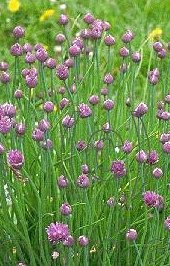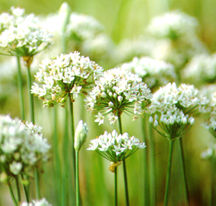 Chives
are
perennials
in the onion and garlic family, and originate
in Europe, Greece, and Italy. They are bulb plants with hollow, cylindrical,
thin, dark green leaves. The flowers are small and a light purple.
Chives make good companion plants to some other vegetables and herbs.
Please see Companion
Planting for more information. Chives can be used fresh,
or chopped and frozen in ice cube trays. They do not dry well (commercially
they are freeze-dried).
Chives
are
perennials
in the onion and garlic family, and originate
in Europe, Greece, and Italy. They are bulb plants with hollow, cylindrical,
thin, dark green leaves. The flowers are small and a light purple.
Chives make good companion plants to some other vegetables and herbs.
Please see Companion
Planting for more information. Chives can be used fresh,
or chopped and frozen in ice cube trays. They do not dry well (commercially
they are freeze-dried).
When harvesting Chives, use your fingers to snap the cylinders from the
base. Scissors will turn the leaves brown at the cut. They have
a mild onion flavor, and are used in herbal vinegars, butters, and cheeses.
They can also be used to flavor salads, soups, and meats.
 Garlic
Chives are a perennial member of the Chive family with leaves that have
a hot, oniony, honey-like, garlic taste and a mild, delicate aroma.
They are used for their leaves, stalks, and flowers. Garlic Chives
can be used in soups, stir-fry, scrambled eggs, and soups. They can
be used as a substitute for garlic, and the flowers make a nice garnish.
Garlic
Chives are a perennial member of the Chive family with leaves that have
a hot, oniony, honey-like, garlic taste and a mild, delicate aroma.
They are used for their leaves, stalks, and flowers. Garlic Chives
can be used in soups, stir-fry, scrambled eggs, and soups. They can
be used as a substitute for garlic, and the flowers make a nice garnish.
Start all Chive varieties in early spring, as they do best cool weather.
They also prefer well drained soil and full sun, but they are not heavy
feeders, so a top dressing of compost every now and then should keep them
healthy and productive. The charming flowers can be used not only
as garnishes for food, but also cut and dried in flower arrangements.
Chives can be propagated by seed or by
root division in the spring. Seed can be tricky, but decent results
can be obtained if care is taken to keep the seedbed moist until the seedlings
are up and established. Established plants need dividing every few
years, and the divisions should be planted in a well-prepared bed enriched
with compost.
Chives make a good container plant and
are a must for any kitchen windowsill herb garden.
 Chives
are
Chives
are  Garlic
Chives are a perennial member of the Chive family with leaves that have
a hot, oniony, honey-like, garlic taste and a mild, delicate aroma.
They are used for their leaves, stalks, and flowers. Garlic Chives
can be used in soups, stir-fry, scrambled eggs, and soups. They can
be used as a substitute for garlic, and the flowers make a nice garnish.
Garlic
Chives are a perennial member of the Chive family with leaves that have
a hot, oniony, honey-like, garlic taste and a mild, delicate aroma.
They are used for their leaves, stalks, and flowers. Garlic Chives
can be used in soups, stir-fry, scrambled eggs, and soups. They can
be used as a substitute for garlic, and the flowers make a nice garnish.